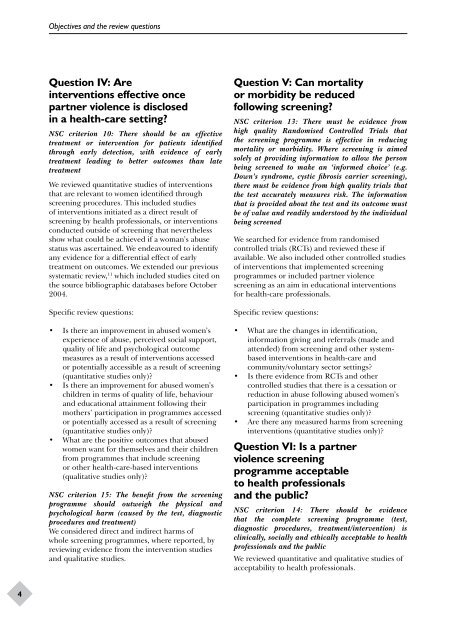How far does screening women for domestic (partner) - NIHR Health ...
How far does screening women for domestic (partner) - NIHR Health ...
How far does screening women for domestic (partner) - NIHR Health ...
You also want an ePaper? Increase the reach of your titles
YUMPU automatically turns print PDFs into web optimized ePapers that Google loves.
4<br />
Objectives and the review questions<br />
Question IV: Are<br />
interventions effective once<br />
<strong>partner</strong> violence is disclosed<br />
in a health-care setting?<br />
NSC criterion 10: There should be an effective<br />
treatment or intervention <strong>for</strong> patients identified<br />
through early detection, with evidence of early<br />
treatment leading to better outcomes than late<br />
treatment<br />
We reviewed quantitative studies of interventions<br />
that are relevant to <strong>women</strong> identified through<br />
<strong>screening</strong> procedures. This included studies<br />
of interventions initiated as a direct result of<br />
<strong>screening</strong> by health professionals, or interventions<br />
conducted outside of <strong>screening</strong> that nevertheless<br />
show what could be achieved if a woman’s abuse<br />
status was ascertained. We endeavoured to identify<br />
any evidence <strong>for</strong> a differential effect of early<br />
treatment on outcomes. We extended our previous<br />
systematic review, 11 which included studies cited on<br />
the source bibliographic databases be<strong>for</strong>e October<br />
2004.<br />
Specific review questions:<br />
• Is there an improvement in abused <strong>women</strong>’s<br />
experience of abuse, perceived social support,<br />
quality of life and psychological outcome<br />
measures as a result of interventions accessed<br />
or potentially accessible as a result of <strong>screening</strong><br />
(quantitative studies only)?<br />
• Is there an improvement <strong>for</strong> abused <strong>women</strong>’s<br />
children in terms of quality of life, behaviour<br />
and educational attainment following their<br />
mothers’ participation in programmes accessed<br />
or potentially accessed as a result of <strong>screening</strong><br />
(quantitative studies only)?<br />
• What are the positive outcomes that abused<br />
<strong>women</strong> want <strong>for</strong> themselves and their children<br />
from programmes that include <strong>screening</strong><br />
or other health-care-based interventions<br />
(qualitative studies only)?<br />
NSC criterion 15: The benefit from the <strong>screening</strong><br />
programme should outweigh the physical and<br />
psychological harm (caused by the test, diagnostic<br />
procedures and treatment)<br />
We considered direct and indirect harms of<br />
whole <strong>screening</strong> programmes, where reported, by<br />
reviewing evidence from the intervention studies<br />
and qualitative studies.<br />
Question V: Can mortality<br />
or morbidity be reduced<br />
following <strong>screening</strong>?<br />
NSC criterion 13: There must be evidence from<br />
high quality Randomised Controlled Trials that<br />
the <strong>screening</strong> programme is effective in reducing<br />
mortality or morbidity. Where <strong>screening</strong> is aimed<br />
solely at providing in<strong>for</strong>mation to allow the person<br />
being screened to make an ‘in<strong>for</strong>med choice’ (e.g.<br />
Down’s syndrome, cystic fibrosis carrier <strong>screening</strong>),<br />
there must be evidence from high quality trials that<br />
the test accurately measures risk. The in<strong>for</strong>mation<br />
that is provided about the test and its outcome must<br />
be of value and readily understood by the individual<br />
being screened<br />
We searched <strong>for</strong> evidence from randomised<br />
controlled trials (RCTs) and reviewed these if<br />
available. We also included other controlled studies<br />
of interventions that implemented <strong>screening</strong><br />
programmes or included <strong>partner</strong> violence<br />
<strong>screening</strong> as an aim in educational interventions<br />
<strong>for</strong> health-care professionals.<br />
Specific review questions:<br />
• What are the changes in identification,<br />
in<strong>for</strong>mation giving and referrals (made and<br />
attended) from <strong>screening</strong> and other systembased<br />
interventions in health-care and<br />
community/voluntary sector settings?<br />
• Is there evidence from RCTs and other<br />
controlled studies that there is a cessation or<br />
reduction in abuse following abused <strong>women</strong>’s<br />
participation in programmes including<br />
<strong>screening</strong> (quantitative studies only)?<br />
• Are there any measured harms from <strong>screening</strong><br />
interventions (quantitative studies only)?<br />
Question VI: Is a <strong>partner</strong><br />
violence <strong>screening</strong><br />
programme acceptable<br />
to health professionals<br />
and the public?<br />
NSC criterion 14: There should be evidence<br />
that the complete <strong>screening</strong> programme (test,<br />
diagnostic procedures, treatment/intervention) is<br />
clinically, socially and ethically acceptable to health<br />
professionals and the public<br />
We reviewed quantitative and qualitative studies of<br />
acceptability to health professionals.
















